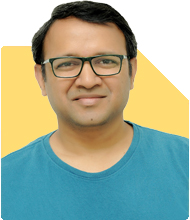48 Years Old, Investing for Retirement - Should I Change My Mutual Funds?
Ramalingam Kalirajan |10894 Answers |Ask -Follow
Mutual Funds, Financial Planning Expert - Answered on Aug 20, 2024
He has an MBA in finance from the University of Madras and is a certified financial planner.
He is the director and chief financial planner at Holistic Investment, a Chennai-based firm that offers financial planning and wealth management advice.... more

Hello Sir, I am 48 years old and I am investing in mutual fund from 2017 and market value of mutual fund portfolio is 37 Lac and I am investing in following MF in through SIP Parag Parikh flexi cap fund 12 K Mirae asset Large and mid cap fund 5K Kotak emerging equity fund 5K Quant Active fund 5K Nippon India small cap fund 5K And following is lumpsum investment Quant large cap fund 250000 DSP Nifty 50 index fund 200000 ICICI pru short term fund 200000 JM flexi cap fund. 100000 Quant mid cap fund. 70000 I am planning to increase SIP by 10000 This I am planning for 10 years plan for retirement Kindly please suggest MF or guide me for any changes if any needed Thank you ???? Raj
However, there are a few areas that could be optimized for better returns and lower risk, especially considering your 10-year retirement goal.
Disadvantages of Index Funds
You've invested a lump sum in an Index Fund. Index Funds track a specific benchmark, usually the Nifty 50 or Sensex. While they have lower expense ratios, they also lack the flexibility to adapt to market changes.
Active funds, on the other hand, allow fund managers to pick stocks that can outperform the market. In the long term, this can result in higher returns. Therefore, considering your retirement goal, shifting from the Index Fund to an actively managed fund might be more beneficial.
Regular Funds vs. Direct Funds
You haven’t specified whether your investments are in regular or direct funds. If you are considering direct funds, it’s important to know their limitations. Direct funds have lower expense ratios, but they don’t come with professional advice.
Certified Financial Planners (CFP) provide guidance, periodic reviews, and help in rebalancing your portfolio based on market conditions and your financial goals. Investing through a CFP ensures your portfolio is always aligned with your objectives.
Evaluation of Your SIPs
Flexi Cap Fund: This is a good choice, providing flexibility to invest across market caps. However, it might be wise to ensure your exposure isn't overly concentrated in any single market cap.
Large & Mid Cap Fund: This fund offers a balance between stability (large caps) and growth potential (mid caps). Continue this SIP as it aligns with your retirement goals.
Emerging Equity Fund: Mid and small caps tend to be more volatile. Consider reviewing this SIP annually to ensure it meets your risk tolerance.
Active Fund: Active funds can outperform benchmarks if managed well. Continue this SIP, but keep track of the fund’s performance.
Small Cap Fund: Small caps can offer high growth but with higher risk. Given your retirement goal, ensure this SIP doesn’t exceed 20% of your total SIPs, as it could add unnecessary volatility to your portfolio.
Assessment of Lump Sum Investments
Large Cap Fund: Large Cap funds are relatively stable, providing consistent returns. This should be a cornerstone of your portfolio.
Index Fund: As discussed, consider switching this to an actively managed fund for better returns.
Short Term Fund: This is a conservative choice, good for parking funds temporarily. However, for long-term growth, these funds may not be ideal.
Flexi Cap Fund: Diversification is key here, and the fund’s flexibility is advantageous. Continue to monitor its performance.
Mid Cap Fund: This fund offers growth potential but with some risk. Ensure this investment complements your overall portfolio strategy without overexposing you to mid-cap volatility.
Increasing Your SIP
Increasing your SIP by Rs 10,000 is a wise decision. Here’s how you might allocate it:
Allocate Rs 5,000 to a Balanced Advantage Fund: This will add stability to your portfolio by balancing equity and debt exposure. It’s a conservative choice that can offer better risk-adjusted returns.
Allocate Rs 5,000 to a Focused Equity Fund: This can potentially offer higher returns as the fund manager focuses on a limited number of high-conviction stocks.
Portfolio Rebalancing and Monitoring
Rebalancing your portfolio regularly is crucial. Markets can be unpredictable, and what works today might not work tomorrow. Review your portfolio every six months to ensure it’s aligned with your risk tolerance and retirement goals.
Final Insights
Your portfolio is well-diversified, but there are opportunities to optimize it further. By shifting from index funds to actively managed funds, and considering the guidance of a Certified Financial Planner, you can potentially achieve better returns. Increasing your SIP is a positive step towards securing your retirement, but make sure to allocate it wisely across different fund categories.
In summary:
Consider shifting from Index Fund to an actively managed fund.
Evaluate your exposure to small caps and ensure it aligns with your risk tolerance.
Invest the additional SIP amount in balanced and focused equity funds.
Regularly rebalance your portfolio and seek guidance from a CFP.
Best Regards,
K. Ramalingam, MBA, CFP,
Chief Financial Planner,
www.holisticinvestment.in
You may like to see similar questions and answers below
Ramalingam Kalirajan |10894 Answers |Ask -Follow
Mutual Funds, Financial Planning Expert - Answered on May 17, 2024
Ramalingam Kalirajan |10894 Answers |Ask -Follow
Mutual Funds, Financial Planning Expert - Answered on Jun 25, 2024
Ramalingam Kalirajan |10894 Answers |Ask -Follow
Mutual Funds, Financial Planning Expert - Answered on Nov 18, 2024
Ramalingam Kalirajan |10894 Answers |Ask -Follow
Mutual Funds, Financial Planning Expert - Answered on Feb 27, 2025
Radheshyam Zanwar |6747 Answers |Ask -Follow
MHT-CET, IIT-JEE, NEET-UG Expert - Answered on Dec 16, 2025
Shalini Singh |181 Answers |Ask -Follow
Dating Coach - Answered on Dec 16, 2025
Patrick Dsouza |1429 Answers |Ask -Follow
CAT, XAT, CMAT, CET Expert - Answered on Dec 16, 2025
Nayagam P P |10858 Answers |Ask -Follow
Career Counsellor - Answered on Dec 16, 2025
Nayagam P P |10858 Answers |Ask -Follow
Career Counsellor - Answered on Dec 16, 2025
Samraat Jadhav |2510 Answers |Ask -Follow
Stock Market Expert - Answered on Dec 16, 2025
Samraat Jadhav |2510 Answers |Ask -Follow
Stock Market Expert - Answered on Dec 16, 2025
Nayagam P P |10858 Answers |Ask -Follow
Career Counsellor - Answered on Dec 16, 2025
Nayagam P P |10858 Answers |Ask -Follow
Career Counsellor - Answered on Dec 16, 2025
Ramalingam Kalirajan |10894 Answers |Ask -Follow
Mutual Funds, Financial Planning Expert - Answered on Dec 16, 2025


























